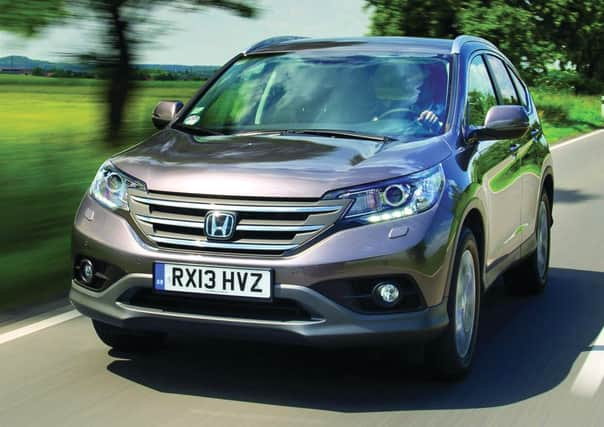Smaller engine keeps Honda CR-V ahead of the curve


These days the focus has shifted, and diesels are not just necessary; a lot of European buyers count on it. The high fuel economy and low carbon-dioxide emissions make it a key selling feature for almost all classes of car.
Inside this CR-V you’ll find a 1.6-litre i-DTEC unit that on the face of it looks rather puny next to the previous-generation car’s 2.2-litre lump, but it delivers a pleasant surprise in that it’s actually very flexible at low revs; something not common in 1.6-litre diesels. It feels, initially, like a much larger engine than it actually is.
Advertisement
Hide AdAdvertisement
Hide AdCombined with an ideal driving position and a firmly-sprung, positive clutch with a direct-feeling gear change action through an extremely well-positioned lever up on the centre console, the diesel CR-V offers encouraging first impressions.
Well, those aren’t quite the first. That honour would go to the design, which makes a rather large car look not so portly at all. Parked in a row of mixed car brands and sizes, the CR-V doesn’t look out of the ordinary thanks to clever proportions that hide some of its true size.
Step into the cabin, though, and the tune rapidly changes. Space is pretty staggering, especially head and shoulder room. You’re not likely to spend much time banging your elbow on the door, either. Petite people might have a job reaching the door with their elbow at all.
With so much space to play with it’s no surprise that Honda has made quite a lot of it, with three large cup holders in the lower centre console backed up by a large central storage bin between the front seats, where you’ll also find the various media input ports. Two slanted bottle holders have been shaped into the front doors, too, and the glove box could stow a horse.
Don’t worry about boot space, either. The load lip is quite high, as with all cars of this type, but there are acres of space for bags and enough vertical room to stack ’em high.
Back in the cabin, absorbing some more of the finer details, there’s a mixed bag to be found. The main instrument cluster seems, at first, a bit messy, but very soon you appreciate why it’s the way it is and it works very well. The large, central speedometer is very easy to read at a glance and the all-analogue gauges are equally clear.
The display screen atop the dashboard struggles, though. In a car with a fabulous array of tech, from heated seats to dual-zone climate control, power-folding door mirrors and a reversing camera, the main display screen is just too small, too far away, too low resolution and too dated in its graphics. It’s OK and it works fine, but compared to the best units among the CR-V’s rivals, it leaves something to be desired.
The engine gets better the more you use it. Like all diesels it clatters about its business at traffic jam speeds, but once you’re up and moving it fades away into the background.
Advertisement
Hide AdAdvertisement
Hide AdThe gearing is interesting, and has been set up for generally lower-speed driving up to, say, 60mph. Fourth, fifth and sixth could be a good bit taller to try to save fuel, but Honda’s engineers have wisely acknowledged the little i-DTEC’s limits and not tried to demand too much from it. As it is, acceleration is still perfectly adequate, while driven gently on a cruise the car – a big thing, remember – can approach 60mpg.
There’s a sense of confidence in the CR-V, partly instilled by its stability and composed ride, but also in its assured practicality. It’s the sort of car that in day-to-day family use would be hard to fault.
VITAL STATS
Engine 1.6-litre, 4cyl diesel, 118bhp, 221lb ft
Performance Top speed 113mph, 0-62mph 11.2 seconds
Economy 62.8mpg
CO2 emissions 119g/km